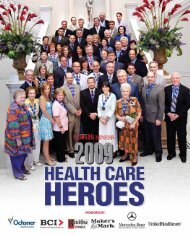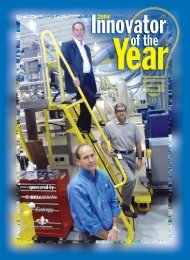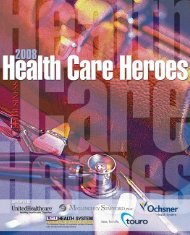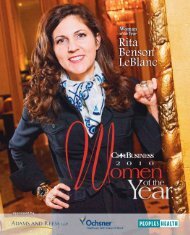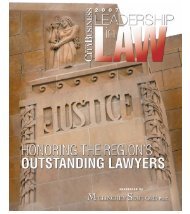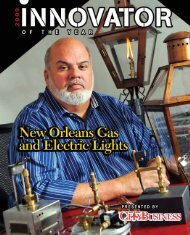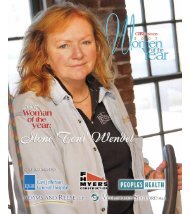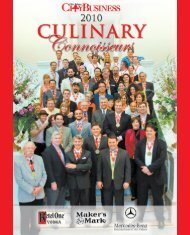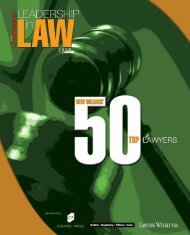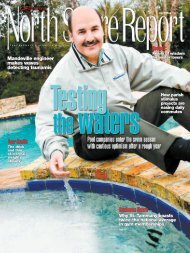INNOVATORS Gold Award - New Orleans City Business
INNOVATORS Gold Award - New Orleans City Business
INNOVATORS Gold Award - New Orleans City Business
- No tags were found...
You also want an ePaper? Increase the reach of your titles
YUMPU automatically turns print PDFs into web optimized ePapers that Google loves.
INNOVATOR<br />
PHOTO BY SHANNON DIECIDUE<br />
Sanichiro Yoshida, with the Southeastern Louisiana University department of chemistry and physics, is working on a technology to identify the weakest spot in materials ranging from plastics to metals.<br />
Optical interferometry<br />
Sanichiro Yoshida<br />
Key innovation: a method to identify the weakest spot<br />
in materials ranging from plastic to metal<br />
Where they’re based: Southeastern Louisiana University<br />
Top executive: Gerard Blanchard, SLU’s chemistry<br />
and physics department chairman<br />
Year introduced: 2008<br />
IF THE MOST important point in any chain is its weakest<br />
link, then Sanichiro Yoshida has developed a process that<br />
could revolutionize the way almost everything is constructed,<br />
from big bridges to the smallest bits of nanotechnology.<br />
Securing a patent this spring for a deformation prediction<br />
instrument, Yoshida, a professor of physics who specializes<br />
in optical interferometry and field theory at Southeastern<br />
Louisiana University’s department of chemistry and<br />
physics, has come up with a method of identifying the weakest<br />
spot in materials ranging from plastic to metal.<br />
“It is something that we have been researching for quite a<br />
long while,” said Yoshida, who first began to do work with<br />
lasers and lights in the early 1980s before also exploring the<br />
possibilities of optical interferometry a decade later.<br />
Working with Russian scientists in Siberia before the<br />
Soviet Union collapsed, Yoshida built upon their research,<br />
which measured changes in the crust of the earth as a means<br />
of predicting earthquakes through the use of satellite technology.<br />
“We went from that use of this application and put it to<br />
other uses,” said Yoshida, who joined the SLU faculty in<br />
1991.<br />
Applying the principles he learned in Siberia to optical<br />
interferometry, Yoshida has been able to measure the differences<br />
in path lengths when a laser is aimed at an object. By<br />
so doing, the laser picks up on displacements in the object,<br />
providing a valuable and economic tool for engineers and<br />
builders.<br />
Yoshida credits SLU’s undergraduate students for helping<br />
him to repeatedly test his theory. He also thanks the<br />
school, which he said has always supported him in his<br />
research.<br />
That support is hardly an accident, said Gerard<br />
Blanchard.<br />
“We look at research itself as a teaching activity here,”<br />
said Blanchard, head of SLU’s chemistry and physics<br />
department, which has a faculty of just more than 24.<br />
That support, Yoshida said, has been critical in the<br />
development of the deformation prediction instrument<br />
— a development that has proceeded over the course of<br />
two decades.<br />
“These things do take a long time,” Yoshida said, “but it’s<br />
not frustrating. I enjoy the process. It’s my life.”•<br />
— Garry Boulard<br />
30A 2008 Innovator of the Year



